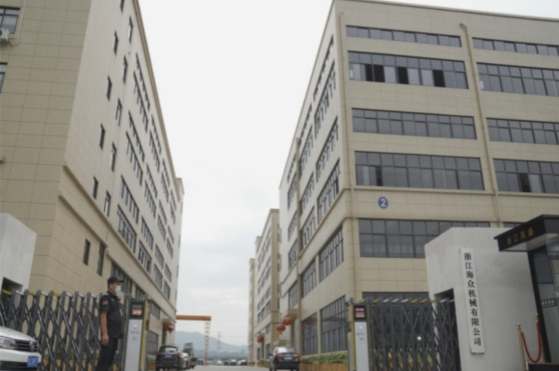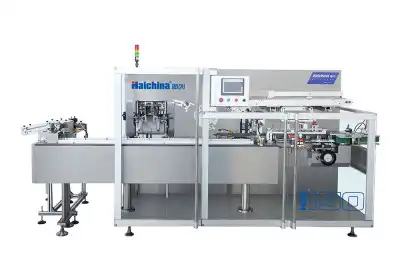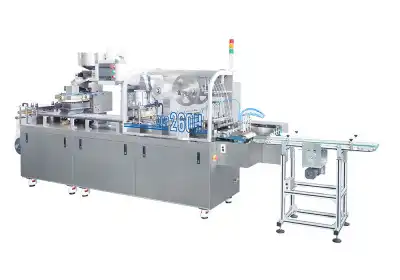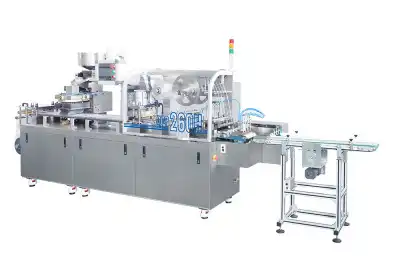Blister Packaging Machine vs. Form-Fill-Seal Machine
When it comes to packaging pharmaceuticals, cosmetics, and food products, two popular options stand out: blister packaging machines and form-fill-seal machines. Both offer unique advantages, but which one is right for your business? Blister packaging machines excel in creating individual, tamper-evident packages ideal for pharmaceuticals and small consumer goods. They offer excellent product protection and visibility. Form-fill-seal machines, on the other hand, are versatile workhorses capable of packaging a wide range of products in various materials. They're often favored for their efficiency in high-volume production. The choice between these two depends on factors such as product type, production volume, and specific industry requirements. Let's delve deeper into the characteristics and benefits of each to help you make an informed decision.

Understanding Blister Packaging Machines: Features and Applications
The Mechanics of Blister Packaging
Blister packaging machines are sophisticated devices designed to create individual, sealed packages for products. The process typically involves forming a cavity or pocket in a plastic film, placing the product into this cavity, and then sealing it with a backing material. This backing can be aluminum foil, paperboard, or another layer of plastic, depending on the product requirements. The machine heats and molds the plastic film to create the cavity, which is then filled with the product. The backing material is then applied and sealed to the formed plastic, creating a secure, individual package. This process can be performed at high speeds, making it suitable for large-scale production.

Advantages of Blister Packaging
Blister packaging offers several key benefits that make it a popular choice across various industries:
- Product Protection: The rigid plastic cavity, formed by blister packaging machines, provides excellent protection against physical damage and contamination.
- Tamper-Evidence: Once sealed, any attempt to access the product becomes immediately apparent, enhancing security.
- Product Visibility: The clear plastic allows consumers to see the product, which can be a significant marketing advantage.
- Portion Control: Each blister contains a specific quantity, making it ideal for pharmaceuticals and single-serve products.
- Extended Shelf Life: The sealed environment created by blister packaging machines can help preserve product freshness and efficacy.

Industries and Products Suited for Blister Packaging
While blister packaging is versatile, it's particularly well-suited for certain industries and products:
- Pharmaceuticals: Pills, capsules, and medical devices benefit from the tamper-evident and portion-control aspects.
- Consumer Electronics: Small gadgets and accessories are protected and showcased effectively.
- Toys and Collectibles: Action figures and collectible items are preserved in their original condition.
- Personal Care Products: Items like razors, toothbrushes, and cosmetics are kept hygienic and visible.
- Hardware and Tools: Small parts and tools are organized and protected from moisture and corrosion.

Exploring Form-Fill-Seal Machines: Versatility and Efficiency
The Form-Fill-Seal Process
Form-fill-seal (FFS) machines are highly versatile packaging systems that create a package from a flat roll of film, fill it with product, and seal it in one continuous process. There are three main types of FFS machines:
- Vertical Form-Fill-Seal (VFFS): Ideal for free-flowing products like snacks, powders, and liquids.
- Horizontal Form-Fill-Seal (HFFS): Suitable for solid or delicate products that require gentle handling.
- Thermoform-Fill-Seal: Creates rigid or semi-rigid packages, often used for meats and dairy products.
The process begins with forming the package from the film, then filling it with the product, and finally sealing it. This all-in-one approach offers high efficiency and flexibility in package design.
Benefits of Form-Fill-Seal Packaging
Form-fill-seal machines, along with blister packaging machines, offer numerous advantages that make them popular across various industries:
- Versatility: Can handle a wide range of products and packaging materials.
- High Production Speeds: Capable of producing hundreds of packages per minute.
- Cost-Effective: Reduces labor costs and material waste.
- Customizable: Allows for easy changes in package size and shape.
- Space-Efficient: Integrates multiple packaging steps into one machine.
- Hygienic: Minimizes human contact with the product during packaging.
Applications and Industries for Form-Fill-Seal Machines
- Form-fill-seal technology finds applications in numerous industries due to its versatility:
- Food and Beverage: Snacks, frozen foods, dairy products, and ready-to-eat meals.
- Pharmaceuticals: Over-the-counter medications and medical supplies.
- Personal Care: Shampoos, lotions, and other liquid or cream-based products.
- Industrial: Hardware, parts, and chemical products.
- Pet Food: Dry and wet pet food packaging.
Making the Right Choice: Factors to Consider
Product Characteristics and Requirements
When choosing between a blister packaging machine and a form-fill-seal machine, consider the following product-related factors:
- Size and Shape: Blister packaging is ideal for small, uniform products, while FFS can accommodate a wider range of sizes and shapes.
- Fragility: Delicate items may benefit from the rigid protection of blister packaging.
- Visibility Requirements: If product visibility is crucial, blister packaging offers a clear advantage.
- Dosage or Portion Control: Blister packs excel in creating individual, precise portions.
- Moisture Sensitivity: Both can offer moisture protection, but the choice of materials may differ.
Production Volume and Speed Requirements
Assess your production needs carefully:
- Output Capacity: FFS machines generally offer higher production speeds for certain types of products.
- Batch Sizes: Blister machines may be more suitable for smaller batches or frequent product changes.
- Flexibility: FFS machines offer more flexibility in terms of package size and shape changes.
- Continuous vs. Intermittent Operation: Consider which machine type aligns better with your production flow.
Cost Considerations and Return on Investment
Evaluate the financial aspects of your choice:
- Initial Investment: Compare the upfront costs of both machine types.
- Operating Costs: Consider factors like energy consumption, material costs, and labor requirements.
- Maintenance Expenses: Factor in the long-term maintenance needs and spare parts availability.
- Scalability: Assess how well each option can adapt to your future growth plans.
- Packaging Material Costs: Compare the costs of blister materials versus FFS film rolls.
Conclusion
The choice between a blister packaging machine and a form-fill-seal machine depends on a careful analysis of your specific product, production requirements, and business goals. Blister packaging machines offer unparalleled product protection and visibility, making them ideal for pharmaceuticals and high-value items. Form-fill-seal machines, with their versatility and high-speed capabilities, are excellent for a wide range of products, especially in high-volume production scenarios.
Contact Us
Ready to explore the right packaging solution for your business? Contact Zhejiang Haizhong Machinery Co.,Ltd. at [email protected] for expert advice and cutting-edge packaging equipment tailored to your specific needs.
References
Johnson, M. (2022). Advances in Pharmaceutical Packaging Technology. Journal of Packaging Science and Technology.
Smith, R. et al. (2021). Comparative Analysis of Blister and FFS Packaging in the Food Industry. International Journal of Food Engineering.
Brown, L. (2023). Sustainability in Packaging: Blister vs. Form-Fill-Seal. Environmental Packaging Innovation Quarterly.
Thompson, K. (2022). Efficiency Metrics in Modern Packaging Systems. Industrial Automation Review.
Garcia, A. and Lee, S. (2021). Consumer Preferences in Product Packaging: A Global Survey. Journal of Marketing Research.
Wilson, D. (2023). The Future of Packaging Machinery: Trends and Predictions. Packaging Technology and Science.

Submit the form now to get a unique quote!

ZHEJIANG HAIZHONG MACHINERY CO., LTD.
Popular Blogs
-
 Successful caseProducts and services
Successful caseProducts and servicesHow to Train Employees to Operate a Bottle Packing Machine Effectively?
-
 Successful caseIndustry insights
Successful caseIndustry insightsThe Blister Packaging Process: A Complete Step-by-Step Guide
-
 Successful caseComparative analysisIndustry insights
Successful caseComparative analysisIndustry insightsWhat Type of PVC Is Best for Blister Packing Machines?